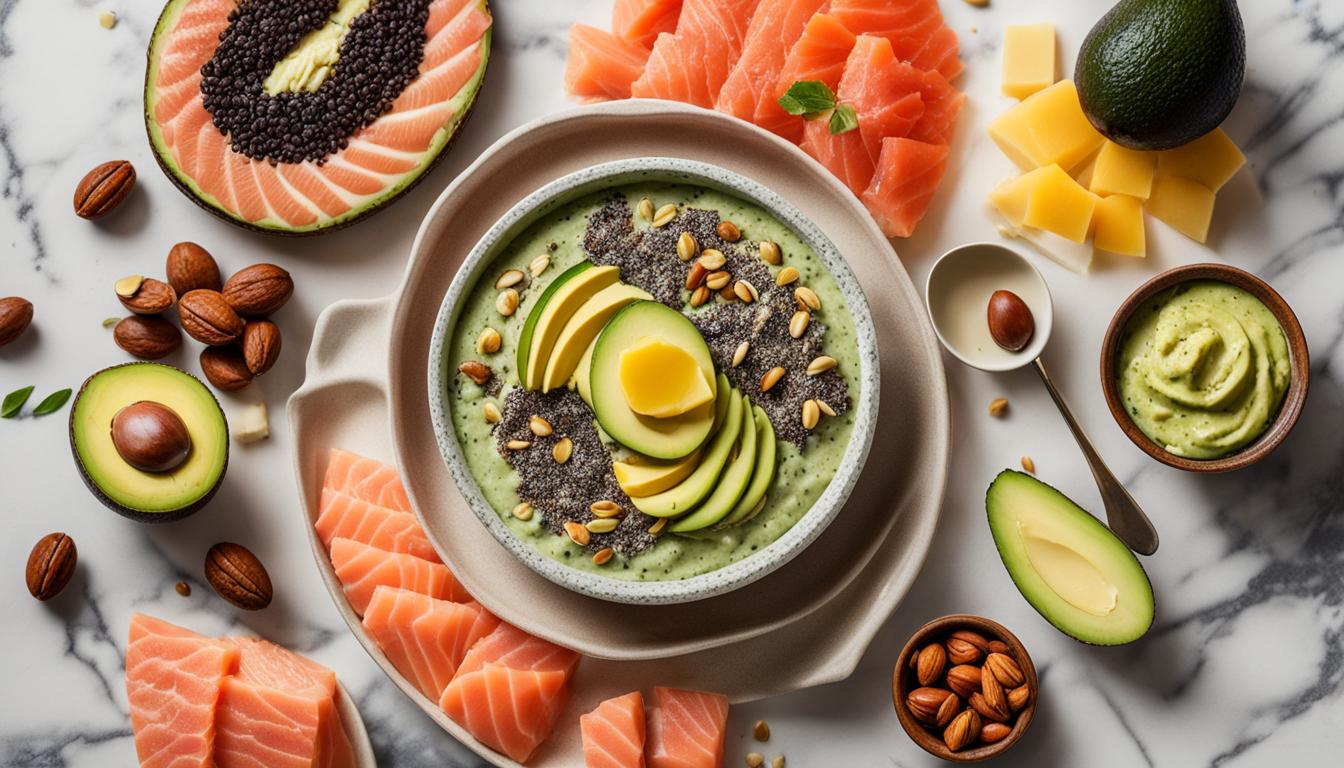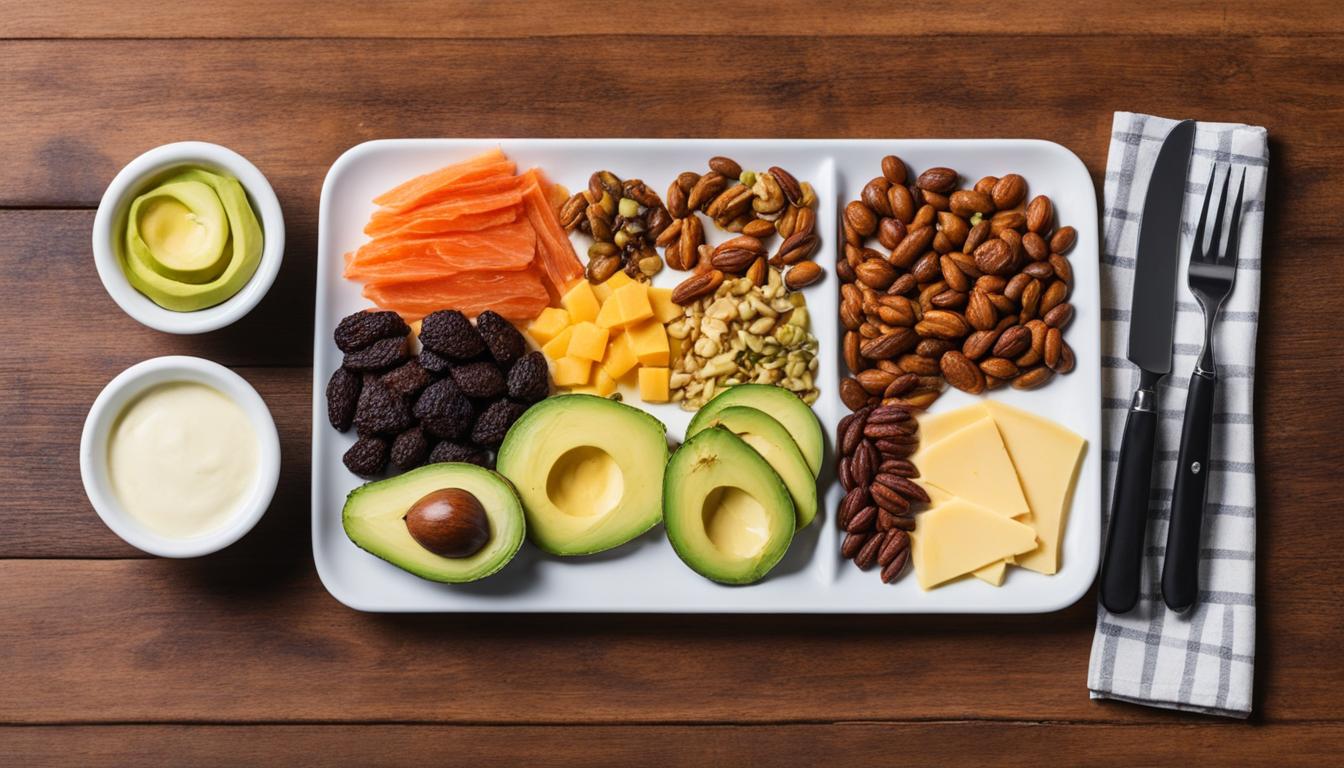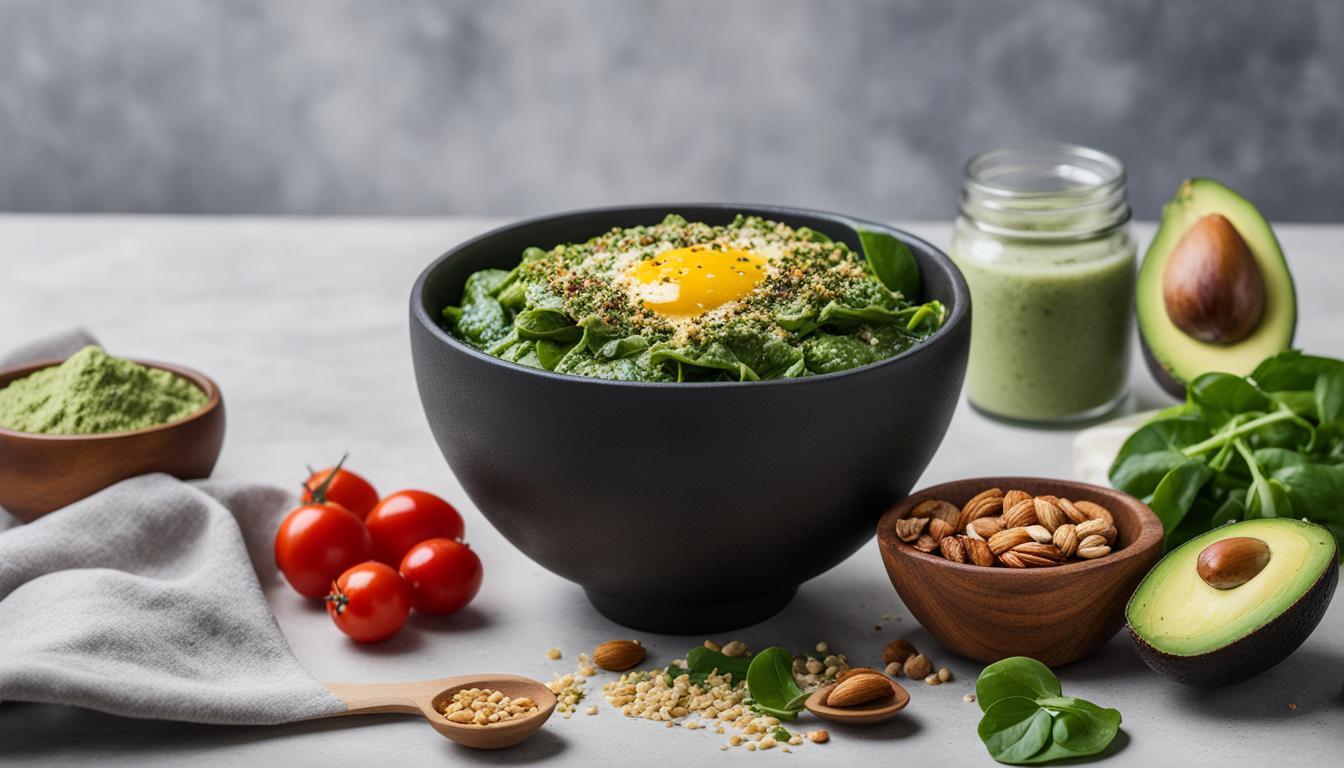The ketogenic diet, also known as the keto diet, is a popular low-carb, high-fat diet that has gained attention for its potential health benefits and weight loss effects. In this article, we will explore the top foods that are high in fat and suitable for keto diets, providing you with the information you need to follow this dietary plan effectively.
On a keto diet, it is essential to get a significant portion of your daily calories from fat. In fact, individuals on the keto diet typically aim to obtain around 55%–60% of their daily calories from fat. By focusing on consuming high-fat, low-carb foods, you can keep your body in a state of ketosis, where it burns fat for fuel instead of carbohydrates.
Key Takeaways:
- Following a ketogenic diet involves getting 55%–60% of your daily calories from fat.
- Choosing the right high-fat, low-carb foods is crucial for maintaining ketosis.
- Healthful fats for the keto diet include olive oil, avocado oil, seeds, nuts, and oily fish.
- It’s important to limit saturated fats, such as red meat, butter, and dairy, and focus on consuming unsaturated fats for optimal health.
- By planning your meals and incorporating high-fat snacks and foods, you can ensure you meet your fat requirements while following the keto diet.
Health Risks of Different Fats
When it comes to the health risks and benefits of different fats, there is ongoing debate among researchers. The Dietary Guidelines for Americans suggest limiting saturated fat intake due to its association with heart disease. However, recent studies have shown that butter, a source of saturated fat, has only a minimal impact on mortality, cardiovascular disease, and diabetes.
On the other hand, consuming higher amounts of unsaturated fats has been linked to a lower risk of mortality. These healthy fats can be found in avocados, nuts, seeds, oily fish like salmon, and olive oil. Incorporating these fats into your ketogenic diet can have potential benefits for your overall health.
Despite being a source of saturated fat, coconut oil has actually been shown to increase HDL cholesterol, commonly known as “good” cholesterol, and protect against heart disease. It’s important to note that not all saturated fats have the same health effects.
On the other hand, trans fats, often found in processed foods, should be strictly avoided on the keto diet. Trans fats raise LDL cholesterol levels, which increases the risk of heart disease.
“It’s important to choose your fats wisely and ensure that you are getting a good balance of different types of fats in your ketogenic diet.”
By incorporating a variety of healthy fats into your daily meals, you can optimize your keto diet and reduce the potential risks associated with certain types of fats.
| Fat Type | Potential Health Risks |
|---|---|
| Saturated Fat | Increased risk of heart disease |
| Unsaturated Fat | Lower risk of mortality |
| Coconut Oil | Benefits in increasing HDL cholesterol and protecting against heart disease |
| Trans Fat | Increased risk of heart disease |
Note: It is crucial to consult with a healthcare professional or registered dietitian when considering your fat choices on the keto diet.
Best Fats for Keto
When it comes to the keto diet, choosing the right fats is essential for achieving and maintaining ketosis. Incorporating healthy fats into your diet not only provides energy but also supports overall health. Here are some of the best fats for keto:
- Oily fish: Rich in omega-3 fatty acids, oily fish like salmon, mackerel, and sardines are excellent choices for the keto diet. These fats have been shown to reduce inflammation, support brain health, and promote heart health.
- Olive oil: Another staple of the Mediterranean diet, olive oil is a great source of monounsaturated fats. It’s rich in antioxidants and has been associated with various health benefits, including a reduced risk of heart disease.
- Avocado oil: With a high smoke point, avocado oil is perfect for cooking at higher temperatures. It’s rich in monounsaturated fats and contains beneficial compounds like vitamin E and beta-sitosterol.
- Nuts and nut butter: Almonds, walnuts, and macadamia nuts are all good sources of healthy fats for keto. They also provide fiber, vitamins, and minerals. However, it’s important to moderate your intake as they can be calorie-dense.
- Seeds: Flaxseeds, chia seeds, and hemp seeds are excellent sources of omega-3 fatty acids and fiber. They can be easily incorporated into your diet by adding them to salads, smoothies, or homemade keto-friendly snacks.
- Olives: Olives are a great source of monounsaturated fats and are packed with antioxidants. They make a delicious and convenient addition to salads, sauces, or enjoyed as a snack.
Despite being a source of saturated fat, coconut oil has some unique health benefits. It contains medium-chain triglycerides (MCTs) that can be quickly converted into ketones, providing a readily available source of energy for those on the keto diet.
Butter is considered keto-friendly, but it’s important to consume it in moderation. While it adds flavor to dishes, it’s high in saturated fat, which should be limited on the keto diet. Opt for grass-fed butter when possible, as it contains higher levels of beneficial nutrients like omega-3 fatty acids.
The amount of fat you should consume on the keto diet depends on your calorie intake and individual needs. However, as a general guideline, aim to get 55%–60% of your daily calories from fat. This ensures that your body has enough fuel to enter and maintain ketosis. Additionally, meal planning and incorporating strategies like adding fats to hot drinks, using high-fat dressings or dips with low-carb vegetables, making fat bombs, eating oily fish, choosing fatty cuts of meat, and incorporating fatty snacks can help ensure you meet your fat goals on the keto diet.
| Fat Sources | Benefits |
|---|---|
| Oily fish | Rich in omega-3 fatty acids, reduces inflammation, supports brain health, promotes heart health |
| Olive oil | High in monounsaturated fats, rich in antioxidants, reduces the risk of heart disease |
| Avocado oil | High smoke point, rich in monounsaturated fats, contains vitamin E and beta-sitosterol |
| Nuts and nut butter | Provides healthy fats, fiber, vitamins, and minerals |
| Seeds | Rich in omega-3 fatty acids and fiber, add texture and nutrients to meals and snacks |
| Olives | Source of monounsaturated fats, packed with antioxidants |
| Coconut oil | Contains MCTs, provides quick energy, supports ketone production |
| Butter | Keto-friendly in moderation, adds flavor, source of saturated fat |

Healthy Keto Fats
When following the keto diet, it’s important to choose healthy fats that provide essential nutrients and support overall well-being. Incorporating these fats into your meals can help you meet the fat requirements of the keto diet while enjoying a variety of delicious foods.
1. Avocados
Avocados are not only delicious but also a fantastic source of healthy fats for the keto diet. They are rich in monounsaturated fats, which are beneficial for heart health. Additionally, avocados are packed with potassium, fiber, and essential vitamins and minerals.
2. Nuts and Seeds
Nuts and seeds make excellent choices for adding healthy fats to your keto diet. They provide a mix of polyunsaturated and monounsaturated fats, along with fiber and protein. Almonds, walnuts, chia seeds, and flaxseeds are examples of nutritious options to include in your meals and snacks.
3. Olive Oil
Olive oil, particularly extra virgin olive oil, is a staple in the Mediterranean diet and is widely recognized for its health benefits. It is high in oleic acid, a monounsaturated fat that has been associated with a lower risk of heart disease. Use olive oil in salad dressings, cooking, or as a dip for bread.
4. Oily Fish
Oily fish such as salmon, mackerel, and tuna are not only delicious but also excellent sources of omega-3 fatty acids. These fats are known for their anti-inflammatory properties and have been linked to various health benefits, including heart health and brain function.
5. Eggs
Eggs are a versatile and nutrient-dense food that can be enjoyed in many ways on the keto diet. Apart from being a great source of healthy fats, eggs provide high-quality protein and essential vitamins and minerals. Incorporate them into your meals as scrambled eggs or omelets.
| Fat Source | Nutrition Benefits |
|---|---|
| Avocados | Monounsaturated fats, potassium, fiber, vitamins, and minerals |
| Nuts and Seeds | Polyunsaturated and monounsaturated fats, fiber, and protein |
| Olive Oil | Monounsaturated fats, oleic acid, associated with lower heart disease risk |
| Oily Fish | Omega-3 fatty acids, anti-inflammatory properties, heart and brain health benefits |
| Eggs | Healthy fats, high-quality protein, essential vitamins, and minerals |
Incorporating these healthy fats into your keto diet not only helps you meet your fat requirements but also adds a variety of flavors and textures to your meals. Experiment with different recipes and meal ideas to keep your keto diet enjoyable and sustainable.
How Much Fat on Keto
The amount of fat you should consume on the keto diet depends on your calorie intake. To maintain a ketogenic state, it is generally recommended that you get 55%–60% of your daily calories from fat.
For example, if you consume 2,000 calories per day, this translates to approximately 122–133 grams of fat daily. However, it’s important to note that individual needs may vary.
Consulting with a healthcare professional or registered dietitian can provide you with personalized guidance on determining the right amount of fat to consume on the keto diet.

Adding healthy fats to your keto diet is essential for achieving and maintaining ketosis. When planning your meals, make sure to choose foods that are high in fat and low in carbs.
Did you know? Unsaturated fats, such as avocados, nuts, seeds, and olive oil, are excellent choices for adding healthy fats to your keto diet. They provide essential nutrients and support overall health.
Incorporating high-fat snacks and foods like avocados, nuts, seeds, and oily fish can help you meet your daily fat requirements. It’s also important to choose fatty cuts of meat and use fats like coconut oil and olive oil in your cooking.
Remember, finding the right balance of fat intake is crucial for the success of your keto journey. Discussing your dietary needs with a healthcare professional will ensure you are on the right track.
Foods High in Fat and Low in Carbs
The key to a successful keto diet is choosing foods that are high in fat and low in carbs. These foods provide the necessary fuel for your body while keeping you in a state of ketosis. By focusing on whole, unprocessed options, you can ensure that you’re getting the nutrients and energy you need while avoiding high-carb temptations.
Here are some examples of foods that are high in fat and low in carbs:
- Avocados: Rich in monounsaturated fat and packed with vitamins and minerals.
- Nuts: Almonds, walnuts, and macadamia nuts are all great sources of healthy fats.
- Olive oil: This heart-healthy oil is a staple in the Mediterranean diet and a great source of monounsaturated fat.
- Oily fish: Salmon, tuna, and mackerel are high in omega-3 fatty acids and provide a good dose of protein.
By incorporating these foods into your keto diet, you can ensure that you’re getting the right balance of fats and carbs. Remember to choose whole, unprocessed options whenever possible to maximize the nutritional benefits.
To further illustrate the benefits of foods high in fat and low in carbs, let’s take a look at the following table:
| Food | Fat Content | Carb Content |
|---|---|---|
| Avocado | 29 grams per avocado | 9 grams per avocado |
| Almonds (1 ounce) | 14 grams | 2.6 grams |
| Olive Oil (1 tablespoon) | 14 grams | 0 grams |
| Salmon (3 ounces) | 13 grams | 0 grams |
As you can see from the table, these foods are not only high in fat but also very low in carbs. This makes them an excellent choice for those following a keto diet. Incorporating these foods into your meals and snacks will help you stay on track and achieve your health and wellness goals.
Meal Planning for Sufficient Fat Intake
Meal planning is a crucial aspect of successfully following the keto diet and ensuring sufficient fat intake. By strategically incorporating high-fat foods into your meals and snacks, you can maximize your fat consumption and maintain ketosis. Here are some helpful meal planning tips to get enough fat on the keto diet:
- Add fats to hot drinks: Start your day by adding a tablespoon of coconut oil, MCT oil, or grass-fed butter to your coffee or matcha tea. This simple addition can help increase your fat intake and keep you satiated throughout the morning.
- Use high-fat dressings or dips: Pair low-carbohydrate vegetables like celery sticks, cucumber slices, or bell pepper strips with creamy dressings or dips made from full-fat mayonnaise, sour cream, or avocado. This combination not only adds flavor but also provides healthy fats.
- Make fat bombs: Fat bombs are convenient and delicious snacks that can help you meet your fat requirements. These treats are typically made with a base of coconut oil or nut butter and can be customized with flavors like chocolate, vanilla, or coconut. Prepare a batch of fat bombs in advance and keep them in the freezer for a quick and satisfying snack.
- Incorporate oily fish: Oily fish like salmon, mackerel, or sardines are not only a great source of omega-3 fatty acids but also provide additional fat to your meals. Consider including these fish in your weekly meal plan to boost your fat intake.
- Choose fatty cuts of meat: Opt for cuts of meat that are naturally higher in fat, such as ribeye steak, pork belly, or chicken thighs with the skin on. Cooking your meat with plenty of healthy fats, like olive oil or butter, can further enhance its fat content.
- Incorporate fatty snacks: Include some fatty snacks throughout the day to increase your fat intake. Olives, boiled eggs, nuts, and avocados are all excellent choices that provide healthy fats and keep cravings at bay.
By being mindful of the fat content in your meals and snacks and incorporating these meal planning strategies, you can ensure sufficient fat intake on the keto diet.
Potential Benefits and Risks of the Keto Diet
The ketogenic diet, also known as the keto diet, has gained popularity for its potential benefits in various aspects of health. However, it is important to understand both the potential benefits and risks associated with this diet.
Potential Benefits
- Improved blood glucose levels: The keto diet may help regulate blood sugar levels, which can be beneficial for individuals with diabetes or insulin resistance.
- Enhanced insulin sensitivity: By limiting carbohydrate intake, the keto diet may improve insulin sensitivity, potentially reducing the risk of metabolic disorders.
- Lower blood pressure: Some studies suggest that the keto diet may lead to a decrease in blood pressure, which can have positive effects on cardiovascular health.
- Weight loss: The keto diet is known for its potential to promote weight loss, primarily by inducing a state of ketosis, where the body burns fat for fuel instead of carbohydrates.
- Management of certain conditions: The keto diet has shown promise in helping individuals manage conditions such as epilepsy, neurological disorders, polycystic ovary syndrome (PCOS), and high cholesterol levels.
Potential Risks
While the keto diet has demonstrated benefits, it also carries potential risks and short-term adverse effects that individuals should be aware of:
- Nutrient deficiencies: The restrictive nature of the keto diet can make it challenging to obtain all essential nutrients, especially if not properly planned.
- Kidney stones: The high intake of animal proteins and limited fluid intake on the keto diet may increase the risk of developing kidney stones.
- Fatty liver disease: Consuming excessive amounts of fat and inadequate amounts of carbohydrates can potentially lead to non-alcoholic fatty liver disease.
- Low levels of protein in the blood: Following a keto diet for a prolonged period may lead to low protein levels in the blood, which can have negative health implications.
Long-Term Effects
The long-term effects of the keto diet are still not well-established. It is generally recommended to follow the diet for a maximum of 6-12 months before gradually transitioning back to a more balanced, sustainable eating pattern.
It is essential to consult with a healthcare professional or registered dietitian before starting the keto diet to ensure it is appropriate for your individual health goals and needs.
Considerations and Precautions
When following the keto diet, it’s important to make considerations and take precautions. Here are some key factors to keep in mind:
- Butter on Keto: Butter can be consumed on the keto diet, but it should be consumed in moderation. While it is a source of saturated fat, it can still be included as part of a balanced keto diet. It’s essential to prioritize a variety of fats to ensure a healthy intake.
- Choosing Good Fats: When selecting fats for your keto diet, focus on incorporating healthy options. Opt for foods high in monounsaturated and polyunsaturated fats like avocados, nuts, seeds, and olive oil. These provide essential nutrients and help maintain the appropriate balance of healthy fats.
- Limiting Unhealthy Fats: It’s crucial to avoid excessive consumption of unhealthy fats on the keto diet. Processed meats, such as hot dogs, bacon, and sausages, should be limited due to their potential health risks. Opt for naturally sourced fats rather than processed alternatives.
- Special Consideration for Type 1 Diabetes: Individuals with type 1 diabetes should avoid the keto diet due to the risk of ketoacidosis. It’s recommended to consult with a healthcare professional for appropriate dietary guidance and to determine the best eating plan.
- Possible Deficiencies and Health Concerns: While the keto diet can be effective for weight loss and other health goals, it may lead to certain vitamin and mineral deficiencies, including calcium, vitamin D, and electrolytes. Additionally, keto diets have been associated with an increased risk of kidney stones, fatty liver disease, and low protein levels in the blood. Listening to your body and consulting with a healthcare professional can help address these concerns.
- Transitioning Off the Keto Diet: It’s important to consider transitioning off the keto diet after 6-12 months. Gradually introducing a wider variety of foods and adjusting macronutrient ratios can help avoid any potential negative effects of prolonged ketosis. Working with a healthcare professional or registered dietitian can provide guidance on a safe and sustainable transition.
By keeping these considerations and precautions in mind, you can make informed decisions and ensure the keto diet is both effective and safe for your health.
Conclusion
In conclusion, the keto diet is a high-fat, low-carb diet that can be effective for weight loss and certain health conditions. To meet the fat requirements of the diet, individuals should focus on incorporating healthful fats such as avocados, nuts, seeds, oily fish, olive oil, and coconut oil. Saturated fats should be limited, while unsaturated fats are beneficial for health.
Meal planning and strategies like adding fats to hot drinks, using vegetables as a vehicle for high fat dressings or dips, making fat bombs, eating oily fish, choosing fatty cuts of meat, and incorporating fatty snacks can significantly contribute to meeting the necessary fat intake on the keto diet.
However, it’s important to consider both the potential benefits and risks of the keto diet. While studies suggest potential benefits for blood glucose levels, insulin sensitivity, and weight loss, there are also potential risks and short-term adverse effects such as nutrient deficiencies and kidney stones. Therefore, it is recommended to consult with a healthcare professional or registered dietitian for personalized guidance and to transition off the keto diet after 6-12 months.
FAQ
What are some top foods high in fat for keto diets?
Some top foods high in fat for keto diets include olive oil, avocado oil, seeds, nuts, and oily fish.
What are the health risks associated with different fats?
Different fats have varying health risks. Saturated fats, such as red meat, butter, and dairy, should be limited. Unsaturated fats, like avocados, nuts, seeds, and olive oil, are beneficial for health. Trans fats, found in processed foods, should be avoided.
What are the best fats for keto?
The best fats for keto include avocados, nuts, seeds, olive oil, oily fish, and eggs.
How much fat should I consume on a keto diet?
The amount of fat a person should consume on a keto diet depends on their calorie intake. As a general guideline, people on the keto diet should aim to get 55%–60% of their daily calories from fat.
What are some foods high in fat and low in carbs?
Foods high in fat and low in carbs include unsaturated fats like avocados, nuts, and olive oil, as well as oily fish like salmon and tuna. It’s important to focus on whole, unprocessed foods and avoid high-carb options such as grains, starchy vegetables, and high-sugar fruits.
How can I ensure I get enough fat on a keto diet?
Meal planning and incorporating high fat snacks and foods can help individuals meet their fat requirements on the keto diet. Adding fats to hot drinks, using high-fat dressings or dips with low-carb vegetables, making fat bombs, choosing fatty cuts of meat, and incorporating fatty snacks like olives and avocados can help increase fat consumption.
What are the potential benefits and risks of the keto diet?
The keto diet has been associated with benefits such as improved blood glucose levels, insulin sensitivity, blood pressure, and weight loss. However, there are potential risks and short-term adverse effects associated with the diet, such as nutrient deficiencies, kidney stones, fatty liver disease, and low protein levels in the blood. Long-term effects of the keto diet are still not well-established.
What considerations and precautions should I take on a keto diet?
While butter can be consumed on the keto diet, it should be consumed in moderation. It’s important to choose grass-fed meat over grain-fed for higher omega-3 content and to limit processed meats. Individuals with type 1 diabetes should avoid the keto diet due to the risk of ketoacidosis. It’s also important to listen to your body, consult with a healthcare professional, and transition off the keto diet after 6-12 months.


